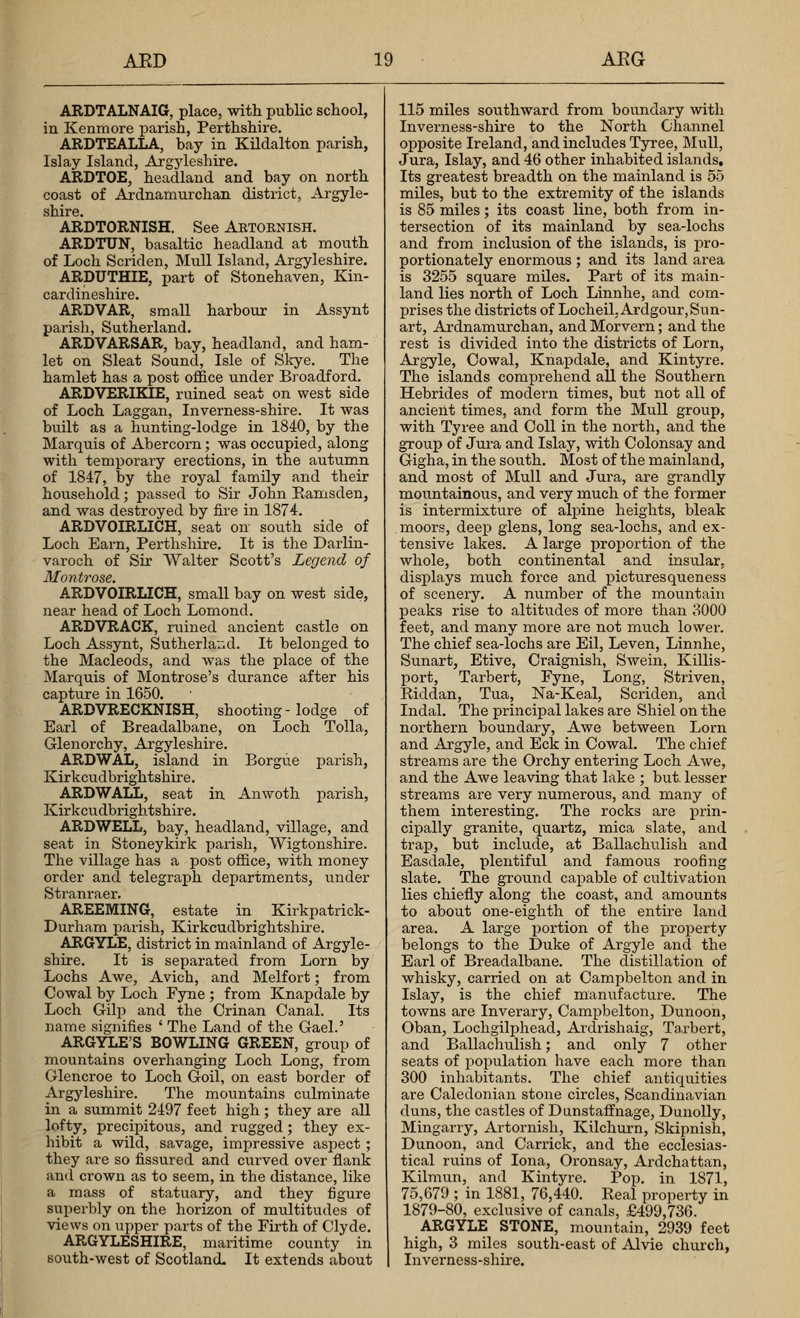ARDTALNAIG, place, with public school, in Kenmore parish, Perthshire.
ARDTEALLA, bay in Kildalton parish, Islay Island, Argyleshire.
ARDTOE, headland and bay on north coast of Ardnamurchan district, Argyleshire.
ARDTORNISH.
ARDTUN, basaltic headland at mouth of Loch Scriden, Mull Island, Argyleshire.
ARDUTHIE, part of Stonehaven, Kincardineshire.
ARDVAR, small harbour in Assynt parish, Sutherland.
ARDVARSAR, bay, headland, and ham-let on Sleat Sound, Isle of Skye. The hamlet has a post office under Broadford.
ARDVERIKIE, ruined seat on west side of Loch Laggan, Inverness-shire. It was built as a hunting-lodge in 1840, by the Marquis of Abercorn ; was occupied, along with temporary erections, in the autumn of 1847, by the royal family and their household ; passed to Sir John Ramsden, and was destroyed by fire in 1874.
ARDVOIRLICH, seat on south side of Loch Earn, Perthshire. It is the Darlin-varoch of Sir Walter Scott's Legend of Montrose.
ARDVOIRLICH, small bay on west side, near head of Loch Lomond.
ARDVRACK, ruined ancient castle on Loch Assynt, Sutherland. It belonged to the Macleods, and was the place of the Marquis of Montrose's durance after his capture in 1650.
ARDVRECKNISH, shooting-lodge of Earl of Breadalbane, on Loch Tolla, Glenorchy, Argyleshire.
ARDWAL, island in Borgue parish, Kirkcudbrightshire.
ARDWALL, seat in Anwoth parish, Kirkcudbrightshire.
ARDWELL, bay, headland, village, and seat in Stoneykirk parish, Wigtonshire. The village has a post office, with money order and telegraph departments, under Stranraer.
AREEMING, estate in Kirkpatrick-Durham parish, Kirkcudbrightshire.
ARGYLE, district in mainland of Argyleshire. It is separated from Lorn by Lochs Awe, Avich, and Melfort ; from Cowal by Loch Fyne ; from Knapdale by Loch Gilp and the Crinan Canal. Its name signifies ' The Land of the Gael.'
ARGYLE'S BOWLING GREEN, group of mountains overhanging Loch Long, from Glencroe to Loch Goil, on east border of Argyleshire. The mountains culminate in a summit 2497 feet high ; they are all lofty, precipitous, and rugged ; they exhibit a wild, savage, impressive aspect ; they are so fissured and curved over flank and crown as to seem, in the distance, like a mass of statuary, and they figure superbly on the horizon of multitudes of views on upper parts of the Firth of Clyde.
ARGYLESHIRE, maritime county in south-west of Scotland, It extends about 115 miles southward from boundary with Inverness-shire to the North Channel opposite Ireland, and includes Tyree, Mull, Jura, Islay, and 46 other inhabited islands. Its greatest breadth on the mainland is 55 miles, but to the extremity of the islands is 85 miles ; its coast line, both from intersection of its mainland by sea-lochs and from inclusion of the islands, is proportionately enormous ; and its land area is 3255 square miles. Part of its main-land lies north of Loch Linnhe, and com-prises the districts of Locheil, Ardgour, Sunart, Ardnamurchan, and Mprvern ; and the rest is divided into the districts of Lorn, Argyle, Cowal, Knapdale, and Kintyre. The islands comprehend all the Southern Hebrides of modern times, but not all of ancient times, and form the Mull group, with Tyree and Coll in the north, and the group of Jura and Islay, with Colonsay and Gigha, in the south. Most of the mainland, and most of Mull and Jura, are grandly mountainous, and very much of the former is intermixture of alpine heights, bleak moors, deep glens, long sea-lochs, and extensive lakes. A large proportion of the whole, both continental and insular, displays much force and picturesqueness of scenery. A number of the mountain peaks rise to altitudes of more than 3000 feet, and many more are not much lower. The chief sea-lochs are Eil, Leven, Linnhe, Sunart, Etive, Craignish, Swein, Killisport, Tarbert, Fyne, Long, Striven, Riddan, Tua, Na-Keal, Scriden, and Indal. The principal lakes are Shiel on the northern boundary, Awe between Lorn and Argyle, and Eck in Cowal. The chief streams are the Orchy entering Loch Awe, and the Awe leaving that lake ; but lesser streams are very numerous, and many of them interesting. The rocks are principally granite, quartz, mica slate, and trap, but include, at Ballachulish and Easdale, plentiful and famous roofing slate. The ground capable of cultivation lies chiefly along the coast, and amounts to about one-eighth of the entire land area. A large portion of the property belongs to the Duke of Argyle and the Earl of Breadalbane. The distillation of whisky, carried on at Campbelton and in Islay, is the chief manufacture. The towns are Inverary, Campbelton, Dunoon, Oban, Lochgilphead, Ardrishaig, Tarbert, and Ballachulish; and only 7 other seats of population have each more than 300 inhabitants. The chief antiquities are Caledonian stone circles, Scandinavian duns, the castles of Dunstaffnage, Dunolly, Mingarry, Artornish, Kilchurn, Skipnish, Dunoon, and Carrick, and the ecclesiastical ruins of lona, Oronsay, Ardchattan, Kilmun, and Kintyre. Pop. in 1871, 75,679 ; in 1881, 76,440. Real property in 1879-80, exclusive of canals, 499,736.
ARGYLE STONE, mountain, 2939 feet high, 3 miles south-east of Alvie church, Inverness-shire.

